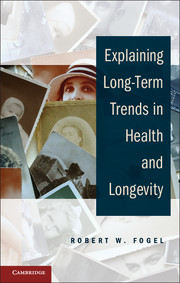Book contents
- Frontmatter
- Contents
- Tables
- Figures
- Acknowledgments
- 1 Foreword
- 2 Secular Changes in American and British Stature and Nutrition
- 3 Second Thoughts on the European Escape from Hunger
- 4 Trends in Physiological Capital
- 5 Changes in Disparities and Chronic Diseases through the Course of the Twentieth Century
- 6 Some Common Problems in Analysis and Measurement
- 7 Afterword
- References
- Index
5 - Changes in Disparities and Chronic Diseases through the Course of the Twentieth Century
Published online by Cambridge University Press: 05 November 2012
- Frontmatter
- Contents
- Tables
- Figures
- Acknowledgments
- 1 Foreword
- 2 Secular Changes in American and British Stature and Nutrition
- 3 Second Thoughts on the European Escape from Hunger
- 4 Trends in Physiological Capital
- 5 Changes in Disparities and Chronic Diseases through the Course of the Twentieth Century
- 6 Some Common Problems in Analysis and Measurement
- 7 Afterword
- References
- Index
Summary
The main proposition of this chapter is that the extent and the severity of chronic conditions in middle and late ages are to a large extent the outcome of environmental insults at early ages, including in utero. Many of these are due to infectious diseases that occur at young ages. Evidence to support this proposition comes partly from the study being conducted at the University of Chicago and elsewhere on the aging of the Union Army veterans, the Early Indicators project. But it is also supported by other longitudinal studies in the United States and abroad. Some recent studies indicate two-generation effects among humans. Perhaps the most widely cited case involves women who were born or were in gestation during the Dutch famine, which lasted about eight or nine months toward the end World War II and was precipitated by sharp reductions in rations. Although this famine resulted in an elevated perinatal death rate, it was for a long time thought that women who survived and were subsequently well fed were just as healthy as women who were born before the famine or afterward. However, when these women themselves began giving birth, their children had elevated perinatal death rates. Of course, we will still have to wait to see what the effects of the famine will be on the rate of increase in chronic conditions and on longevity at older ages. However, there is evidence that children of mothers who were in the first trimester of gestation when the famine struck and who survived infancy have elevated prevalence of coronary heart disease now that they are in their mid-fifties (Roseboom et al. 2000).
Environmental conditions were far more severe during the beginning of the twentieth century, and differences in exposure to disease varied sharply by socioeconomic group. For example, the infant death rate from diarrheal diseases during the summer months in Chicago in 1910 for foreign-born mothers was nine times as high as the rate for native-born mothers (Bridges 2002).
Information
- Type
- Chapter
- Information
- Explaining Long-Term Trends in Health and Longevity , pp. 106 - 119Publisher: Cambridge University PressPrint publication year: 2012
